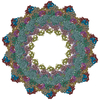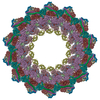+ Open data
Open data
- Basic information
Basic information
| Entry | Database: PDB / ID: 9h2a | ||||||
|---|---|---|---|---|---|---|---|
| Title | AcMNPV complete basal cap | ||||||
 Components Components |
| ||||||
 Keywords Keywords | VIRUS / nucleocapsid | ||||||
| Function / homology |  Function and homology information Function and homology informationtransport of viral material towards nucleus / exit of virus from host cell nucleus by nuclear egress / host cell nuclear matrix / nuclear capsid assembly / symbiont-mediated perturbation of host cell cycle progression / virion component / viral capsid / host cell / viral nucleocapsid / host cell cytoplasm ...transport of viral material towards nucleus / exit of virus from host cell nucleus by nuclear egress / host cell nuclear matrix / nuclear capsid assembly / symbiont-mediated perturbation of host cell cycle progression / virion component / viral capsid / host cell / viral nucleocapsid / host cell cytoplasm / viral envelope / host cell nucleus / virion membrane / structural molecule activity / protein homodimerization activity / DNA binding / membrane Similarity search - Function | ||||||
| Biological species |  Autographa californica nucleopolyhedrovirus Autographa californica nucleopolyhedrovirus | ||||||
| Method | ELECTRON MICROSCOPY / single particle reconstruction / cryo EM / Resolution: 5.2 Å | ||||||
 Authors Authors | Effantin, G. / Kandiah, E. / Pelosse, M. | ||||||
| Funding support | 1items
| ||||||
 Citation Citation |  Journal: Nat Commun / Year: 2025 Journal: Nat Commun / Year: 2025Title: Structure of AcMNPV nucleocapsid reveals DNA portal organization and packaging apparatus of circular dsDNA baculovirus. Authors: Gregory Effantin / Eaazhisai Kandiah / Martin Pelosse /  Abstract: Baculoviruses are large DNA viruses found in nature propagating amongst insects and lepidoptera in particular. They have been studied for decades and are nowadays considered as invaluable ...Baculoviruses are large DNA viruses found in nature propagating amongst insects and lepidoptera in particular. They have been studied for decades and are nowadays considered as invaluable biotechnology tools used as biopesticides, recombinant expression systems or delivery vehicle for gene therapy. However, little is known about the baculovirus nucleocapsid assembly at a molecular level. Here, we solve the whole structure of the Autographa californica multiple nucleopolyhedrovirus (AcMNPV) nucleocapsid by applying cryo-electron microscopy (CryoEM) combined with de novo modelling and Alphafold predictions. Our structure completes prior observations and elucidates the intricate architecture of the apical cap, unravelling the organization of a DNA portal featuring intriguing symmetry mismatches between its core and vertex. The core, closing the capsid at the apex, holds two DNA helices of the viral genome tethered to Ac54 proteins. Different symmetry components at the apical cap and basal structure are constituted of the same building block, made of Ac101/Ac144, proving the versatility of this modular pair. The crown forming the portal vertex displays a C21 symmetry and contains, amongst others, the motor-like protein Ac66. Our findings support the viral portal to be involved in DNA packaging, probably in conjunction with other parts of a larger DNA packaging apparatus. | ||||||
| History |
|
- Structure visualization
Structure visualization
| Structure viewer | Molecule:  Molmil Molmil Jmol/JSmol Jmol/JSmol |
|---|
- Downloads & links
Downloads & links
- Download
Download
| PDBx/mmCIF format |  9h2a.cif.gz 9h2a.cif.gz | 1.5 MB | Display |  PDBx/mmCIF format PDBx/mmCIF format |
|---|---|---|---|---|
| PDB format |  pdb9h2a.ent.gz pdb9h2a.ent.gz | 1.2 MB | Display |  PDB format PDB format |
| PDBx/mmJSON format |  9h2a.json.gz 9h2a.json.gz | Tree view |  PDBx/mmJSON format PDBx/mmJSON format | |
| Others |  Other downloads Other downloads |
-Validation report
| Summary document |  9h2a_validation.pdf.gz 9h2a_validation.pdf.gz | 1.8 MB | Display |  wwPDB validaton report wwPDB validaton report |
|---|---|---|---|---|
| Full document |  9h2a_full_validation.pdf.gz 9h2a_full_validation.pdf.gz | 1.9 MB | Display | |
| Data in XML |  9h2a_validation.xml.gz 9h2a_validation.xml.gz | 217.7 KB | Display | |
| Data in CIF |  9h2a_validation.cif.gz 9h2a_validation.cif.gz | 334.2 KB | Display | |
| Arichive directory |  https://data.pdbj.org/pub/pdb/validation_reports/h2/9h2a https://data.pdbj.org/pub/pdb/validation_reports/h2/9h2a ftp://data.pdbj.org/pub/pdb/validation_reports/h2/9h2a ftp://data.pdbj.org/pub/pdb/validation_reports/h2/9h2a | HTTPS FTP |
-Related structure data
| Related structure data |  51791MC  9h1sC  9h2bC  9h2cC  9h2hC  9h2jC  9h2kC C: citing same article ( M: map data used to model this data |
|---|---|
| Similar structure data | Similarity search - Function & homology  F&H Search F&H Search |
- Links
Links
- Assembly
Assembly
| Deposited unit | 
|
|---|---|
| 1 | x 7
|
| Symmetry | Point symmetry: (Schoenflies symbol: C7 (7 fold cyclic)) |
- Components
Components
-Protein , 7 types, 32 molecules ABOPQRCDSTUVEWFXGHMNYZefIJKabcLd
| #1: Protein | Mass: 33568.152 Da / Num. of mol.: 6 / Source method: isolated from a natural source Source: (natural)  Autographa californica nucleopolyhedrovirus Autographa californica nucleopolyhedrovirusReferences: UniProt: P41702 #2: Protein | Mass: 41583.594 Da / Num. of mol.: 6 / Source method: isolated from a natural source Source: (natural)  Autographa californica nucleopolyhedrovirus Autographa californica nucleopolyhedrovirusReferences: UniProt: P25695 #3: Protein | Mass: 38070.500 Da / Num. of mol.: 2 / Source method: isolated from a natural source Source: (natural)  Autographa californica nucleopolyhedrovirus Autographa californica nucleopolyhedrovirusReferences: UniProt: P24745 #4: Protein | Mass: 55480.898 Da / Num. of mol.: 2 / Source method: isolated from a natural source Source: (natural)  Autographa californica nucleopolyhedrovirus Autographa californica nucleopolyhedrovirusReferences: UniProt: P41700 #5: Protein | Mass: 38991.109 Da / Num. of mol.: 8 / Source method: isolated from a natural source Source: (natural)  Autographa californica nucleopolyhedrovirus Autographa californica nucleopolyhedrovirusReferences: UniProt: P17499 #6: Protein | Mass: 79974.469 Da / Num. of mol.: 6 / Source method: isolated from a natural source Source: (natural)  Autographa californica nucleopolyhedrovirus Autographa californica nucleopolyhedrovirusReferences: UniProt: Q00733 #7: Protein | Mass: 44851.441 Da / Num. of mol.: 2 / Source method: isolated from a natural source Source: (natural)  Autographa californica nucleopolyhedrovirus Autographa californica nucleopolyhedrovirusReferences: UniProt: P41662 |
|---|
-Non-polymers , 1 types, 8 molecules 
| #8: Chemical | ChemComp-ZN / |
|---|
-Details
| Has ligand of interest | Y |
|---|---|
| Has protein modification | Y |
-Experimental details
-Experiment
| Experiment | Method: ELECTRON MICROSCOPY |
|---|---|
| EM experiment | Aggregation state: PARTICLE / 3D reconstruction method: single particle reconstruction |
- Sample preparation
Sample preparation
| Component | Name: Autographa californica nucleopolyhedrovirus / Type: VIRUS / Entity ID: #1-#7 / Source: NATURAL |
|---|---|
| Source (natural) | Organism:  Autographa californica nucleopolyhedrovirus Autographa californica nucleopolyhedrovirus |
| Details of virus | Empty: NO / Enveloped: YES / Isolate: STRAIN / Type: VIRION |
| Buffer solution | pH: 7 |
| Specimen | Embedding applied: NO / Shadowing applied: NO / Staining applied: NO / Vitrification applied: YES |
| Vitrification | Cryogen name: ETHANE |
- Electron microscopy imaging
Electron microscopy imaging
| Experimental equipment |  Model: Titan Krios / Image courtesy: FEI Company |
|---|---|
| Microscopy | Model: TFS KRIOS |
| Electron gun | Electron source:  FIELD EMISSION GUN / Accelerating voltage: 300 kV / Illumination mode: FLOOD BEAM FIELD EMISSION GUN / Accelerating voltage: 300 kV / Illumination mode: FLOOD BEAM |
| Electron lens | Mode: BRIGHT FIELD / Nominal defocus max: 2500 nm / Nominal defocus min: 1000 nm |
| Image recording | Electron dose: 30 e/Å2 / Film or detector model: GATAN K3 BIOQUANTUM (6k x 4k) |
- Processing
Processing
| CTF correction | Type: PHASE FLIPPING AND AMPLITUDE CORRECTION |
|---|---|
| 3D reconstruction | Resolution: 5.2 Å / Resolution method: FSC 0.143 CUT-OFF / Num. of particles: 35066 / Symmetry type: POINT |
 Movie
Movie Controller
Controller













 PDBj
PDBj
